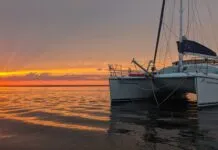Anchored Out
Boatowners who have the option of moving their boats to protected water before a hurricane strikes should consider rivers, canals, or backwater creeks instead of marinas. If the site is a narrow canal or river, you may be able to run multiple lines ashore to trees or mangroves on both sides. If the waterway is wide, you can also anchor.
Marine-industry professionals advise using helix moorings, but there are some other anchoring techniques that can work as well. The key is to use more and larger anchors, and those that are appropriate for the type of bottom. Boats have survived hurricanes when anchored with two anchors with unequal-length lines set 60 to 90 degrees apart.
Another arrangement consists of using three very large anchors set 120 degrees apart with the rodes leading to a central pennant. Note that each anchor must be capable of taking the full load.
A tandem anchoring system, where a second anchor is attached to the first one via a length of chain, adds additional holding power. With any of these systems, some kind of snubber-like length of nylon line must be incorporated into the chain rode(s). Deep-water anchorages will see less wave action than shallow ones, allowing the chain catenary to absorb some of the load.
Whether your vessel is moored or anchored, chafe will be a certainty if the storm hits, so proper chafe protection is imperative. Also, if your boat will be riding the storm out on a mooring, make sure the chain, swivels, and pennant on that mooring have been checked recently for wear.
The following is a two-anchor mooring system Practical Sailor Technical Editor Ralph Naranjo has used with success in various locations to moor his 41-foot Ericson sloop, Wind Shadow. At the heart of the system are two sets of ground tackle:
– A 45-pound CQR, with l0-millimeter (3/8-inch) all-chain rode, 3/8-inch nylon snubber, and leather anti-chafe gear.
– A Paul Luke 75-pound, three-piece fisherman storm anchor, 50-feet of 1/2-inch chain, 200-feet of 3/4-inch nylon, leather anti-chafe gear (no swivel).
Set the two anchors at about a 60-degree angle, placing the storm anchor opposite the worst of the expected wind and fetch. Leave enough swinging room to cope with the likely wind shift, which could be as much as 180 degrees. No swivels! Both anchors and rodes provide great reset ability. Make sure the cleats and deck can take the load.
A mast on a modern sailboat is not meant to be a bollard. Use the winch pedestals and sheets as a safety back up. Make sure scope can be added and use the engine to alleviate strain if crew remains aboard.
For more advice on preparing your boat for an upcoming storm, purchase Bill Seiferts Offshore Sailing, 200 Essential Passagemaking Tips today!




































